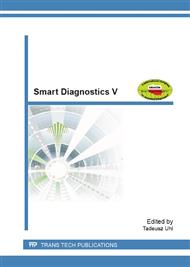[1]
F.P. Sun, Z. Chaudhry, C. Liang, C.A. Rogers, Truss structure integrity identification using PZT sensor–actuator, J. Intel. Mat. Syst. Str. 6 (1995) 134-139.
DOI: 10.1177/1045389x9500600117
Google Scholar
[2]
M. Rosiek, A. Martowicz, T. Uhl, Electromechanical impedance based SHM system for aviation applications. Key Eng. Mater. 518 (2012) 127-136.
DOI: 10.4028/www.scientific.net/kem.518.127
Google Scholar
[3]
Y.L. Koh, N. Rajic, W.K. Chiu, S. Galea, Smart structure for composite repair, Compos. Struct. 47 (1999) 745-752.
DOI: 10.1016/s0263-8223(00)00048-9
Google Scholar
[4]
V. Giurgiutiu, Structural Health Monitoring with Piezoelectric Wafer Active Sensors, first ed., Elsevier Academic Press, (2007)
Google Scholar
[5]
V. Giurgiutiu, A. Zagrai, Damage detection in simulated aging-aircraft panels using the electro-mechanical impedance technique for aging aircraft structural health monitoring, Adaptive Structures and Material Systems Symposium, ASME Winter Annual Meeting, USA (2000) 1-10.
DOI: 10.1115/imece2000-1725
Google Scholar
[6]
D. Roach, K. Rackow Health monitoring of aircraft structures using distributed sensor systems, Sandia National Laboratories, FAA Airworthiness Assurance Center Albuquerque, NM 87185 (2006).
Google Scholar
[7]
J. MacArthur, Air Disaster (Vol. 2), Motorbooks International, 1996.
Google Scholar
[8]
G. Park, H. Sohn, C.R. Farrar, Overview of piezoelectric impedance-based health monitoring and path forward, Shock Vib. 35(6) (2003) 451-463.
DOI: 10.1177/05831024030356001
Google Scholar
[9]
F.P. Sun, C.A. Rogers, C. Liang, Structural Frequency Response Function Acquisition via Electric Impedance Measurement of Surface-Bonded Piezoelectric Sensor/Actuator, Proc. 36th AIAA/ASME/ASCE/AHS/ASC Structures, Structural Dynamics, and Materials Conf., New Orleans, USA (1996) 3450-3461.
DOI: 10.2514/6.1995-1127
Google Scholar
[10]
V. Raju, G. Park, H. Cudney, Impedance-based Health Monitoring Technique of Composite Reinforced Structures, Proc. 9th International Conference on Adaptive Structures and Technologies, Cambridge, USA (1998) 448-457.
Google Scholar
[11]
M. Rosiek, A. Martowicz, T. Uhl, Structural health monitoring system based on electromechanical impedance measurements, Proc. 8th International Workshop on Structural Health Monitoring. Stanford, USA (2011) 314-321.
Google Scholar
[12]
M. Bauccio, Ed. ASM Metals Reference Book, Third edition, ASM International, Materials Park, USA (1993).
Google Scholar


